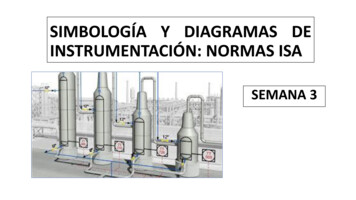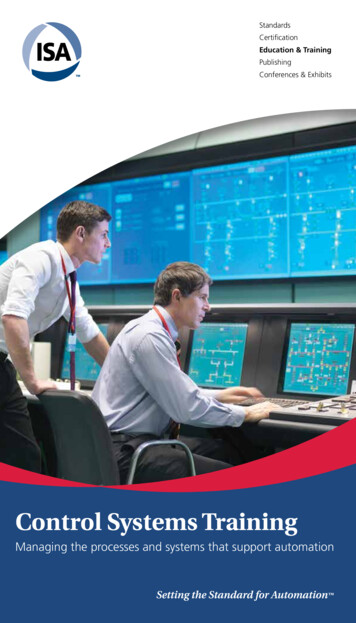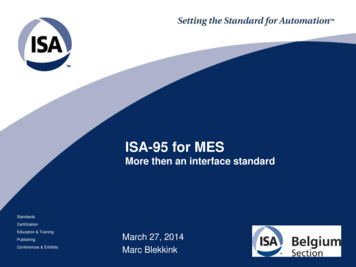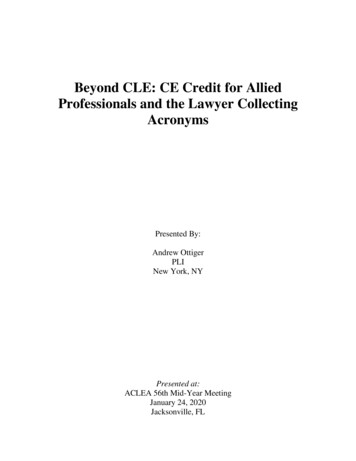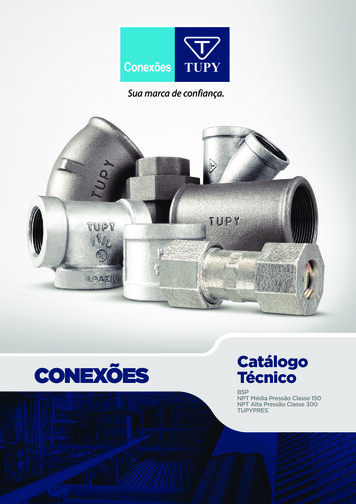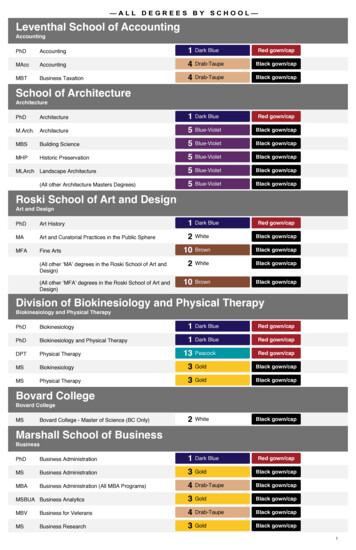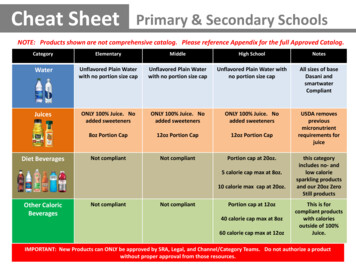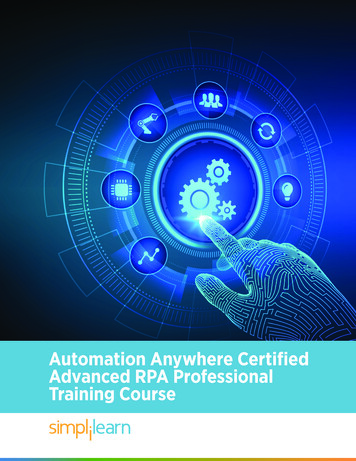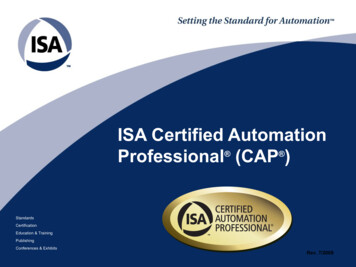
Transcription
ISA Certified AutomationProfessional (CAP )StandardsCertificationEducation & TrainingPublishingConferences & ExhibitsRev. 7/2009
Overview of this PresentationCAP Overview and Discussion of BenefitsComparison of CAP to Other CertificationsHow to Become a CAPOverview of the CAP ExamWhat Can You Do About CAP?Note to presenter:See the instructor notes on title slide.
CAP OverviewandDiscussion of Benefits
Major New Certification by ISA “High Stakes” certification used for hiring, advancement,and contracting decisions Setting the standard for automation knowledge Worldwide credibility Not just one more credential, THE credential forprofessional level automation knowledge
Market Studies Show Strong Interest inAutomation Certification 77% of the respondents believed certification would enhancerecognition and respect for individuals working in this field 67% of the respondents reported that certification in this field wouldbe valuable to their organization. 64% of the employer respondents agreed thatsalary/remuneration/benefits should increase for certified industrialautomation professionals. 77% of respondents indicated that they would encourage eligibleemployees to seek certification in this field if it is offered by ISA.
Employer respondents citedthe following benefits for CAP: -Increased quality-Safety-Standardization-Professional recognition-Additional means of evaluating potential job candidates-Help to weed out amateurs posing as automationspecialists
Who Is ISA? A leading, global, nonprofit organization Setting the standard for automation 30,000 worldwide members Develops standardsCertifies industry professionalsProvides education and trainingPublishes books and technical articlesHosts a number of conferences including the largest conference andexhibition for automation professionals in North America.
Like certifications in many other fields,CAP adoption driven by: Individual automation professionalswho want to distinguish their automation knowledge Companies with professional automation employeeswho want to advance the education of their employees Companies providing automation serviceswho want to distinguish themselves in the market Users of automation serviceswho want to improve the quality of services they purchase rather than by any legal requirement
CAP Benefits IndividualAutomation Professionals Enhances professional credibility––––Travel from job to job and provide immediate proof of ability.Younger professionals increase their recognition and credibilityMid-range professionals validate and document their range of knowledgeThose nearing retirement enhance their future marketability Enhances self image Improves career opportunities promotion, pay increases, job portability Encourages life long learning and professional developmentIndividuals also tend to be early adopters of a new certification and many have achieved CAP status have done so to enhance theirown credibility
CAP Benefits Employers ofAutomation Professionals Develops a better trained workforce– Provides documented evidence that employees are qualified to do theirjob. Such documentation is a requirement of the ISO 9001 standard. Incentive for employees to remain currentPromotes safe practicesQualification tool for hiring and advancement decisionsEnhances company image with internal or externalcustomersEmployers tend to be early adopters of a new certification and many employers are encouraging their key employees tobecome certified
CAP Benefits Companies ProvidingAutomation Services Provider companies can distinguish themselves in themarket by advertising that their employees are certified Many users of automation technician services requireCCST certification,and providers who can supply CCSTs have an advantage –the same thing will happen with CAP Qualified automation professionals doing the work resultsin fewer call-backs, less rework, and higher profits
CAP Benefits Companies Contractingfor Automation Services When outside companies do your automation designhow do you know that – The people doing the work on your projects are competent?– Your safety critical systems are designed in the best way and tothe latest standards?– Your plant will get the greatest advantage from the lateststandards on batch recipe management, data integration,fieldbus, wireless, and other areas? If the people doing your work have a CAP credential ––––They have demonstrated competenceTheir knowledge of automation is well above averageThey are much more likely to know the latest standardsContinuing education requirements keep knowledge up-to-date
More Competent Automation ProfessionalsDevelop Automation Systems that Are less expensive Operate more efficiently Are easier for operators to work with Are easier to maintain Have fewer mistakes in design that have to be corrected Startup hours or even days faster Have fewer unplanned shutdowns Utilize the latest, most cost effective standards appropriately Avoid safety incidents Avoid environmental incidents
Who are Automation Professionals? Automation Professionals are:– responsible for the direction, definition, design, development/application, deployment, documentation, and support of systems,software, and equipment used in control systems, manufacturinginformation systems, systems integration, and operational consulting Work for– End-users– Engineering contractors– Specialty automation and manufacturing information providersincluding System Integrations andapplication services divisions of supplier companies– Hardware and Software product companiesas application engineers, sales personnel and product developers
Requirements for CAP Education - Experience– Four-year technical degree (engineering, engineering technology,computer science, math, science, etc.) five years experience– Two-year technical degree eight years experience including twoyears in responsible charge– Without a degree, ten years of experience including two years inposition of responsible charge Exam– Pass a comprehensive exam Continuing automation education– 45 hours every three years (average of 15 hours per year)
CAP Exam Covers the Automation Body of Knowledge Difficult and comprehensive – if it wasn’t a tough examthe certification wouldn’t mean much – but passable by many automation professionals,particularly after studying less familiar topics– Experience helps– Pass rate is about 2/3 Multiple choice questions Testing locations worldwide Testing available every business day and Saturdays at somelocations
Who should become CAP certified? People working in automation at the professional levelemployed by:–––– End usersSystem integratorsEngineering contractorsVendorsTechnical supervisorsTechnical sales personnelAutomation educatorsISA leaders in particular should become certified (CAP orCCST) if their work background is appropriate -- section officers, districtofficers, division officers, and society officers
What some current CAPs are saying: “The CAP has given me a way to prove to my employerthat I have knowledge of automation” “Since I don’t have a degree, becoming a CAP is the onlyway I can show my next employer that I am competent inautomation” “I’m nearing retirement and the CAP will help me be moreattractive for part-time work” “In our company, people advance faster with the rightcredential. CAP is that credential in the automation area” “My company is using CAP to demonstrate to ourcustomers that we have competent personnel”
Comparison of CAP toOther Credentials
Three Types of Credentials Certificate– Evidence of taken course or series of courses on one subject– Example: ISA Leadership Development Certificate Program– Usually only requires participation License– legal right to practice in broad area– Examples: medical doctor, professional engineer– Requires education, comprehensive exam and possiblycontinuing education Certification– generally narrower area than license– Examples: Certified Opthalmologist, Project ManagementProfessional, Certified Automation Professional– Requires education, experience, exam and continuing education
Hundreds of Certifications are in Use Today Many certifications have a legal requirement –particularly in the health field Hundreds of certifications are voluntary Professional Engineer Registration in the U.S.– Control System Engineering Certified Control System Technician
Examples of Voluntary Certifications Project Management Professional (PMP) – over 200,000 active,38% outside North America Certified Safety Professional – 20% salary differential vs. those notcertified doing similar work - 18,000 awarded, 10% are also P.E.s Certified Industrial Hygienist –virtually all practitioners in this areaare certified Certified Manufacturing Engineer (CMfgE) – 12,000 are certifiedby Society of Manufacturing Engineers Certified Quality Engineer (CQE) Certified HR Professional
Each of these certifications Have been shown to increase job opportunities for thoseholding the certification Some are essentially required to work in the respectivefield in some industries or companies Enhances competitiveness of companies offeringservices
What about the United StatesProfessional Engineer (P.E.) License? P.E. is legal license granted by states in the U.S. The P.E. exam can be taken in many technical areas –so does not certify competence in any specific area Most states require an approved engineering degree(generally engineering technology and computer science do not qualify) U. S. only 15% of ISA members report that they have a P.E. Very little automation work requires the P.E.
CSE option in the P.E. is morespecific to automation Control System Engineering (CSE) exam demonstratescompetence in process control -so has similarities with certificationsBUT CSE focuses only on process control area of automation CSE is not usually identified in the P.E. designation so isnot a good indicator of automation knowledge CSE will apparently never reach critical mass– Only about 1% of automation professionals in the U.S. have passed in 14 years– Less than 1% of ISA members report that they have passed the CSE
In automation, P.E.s and CAPsdo the same type of work, but CAP demonstrates competence across the entireautomation field CAP includes the large number of automationprofessionals with degrees in areas other than engineering CAP is worldwide and has worldwide credibility The number of CAPs will reach critical mass in a few yearsCAP will be the de facto standard for demonstrating automation competence CAP is not a legal “license” to practice automation
Comparison to the Certified ControlSystem Technician (CCST ) The job description of a CCST includes:– Calibration– Loop Checking– Troubleshooting– Start-Up– Maintenance/Repair– Project Organization– Administration These are significantly different tasks from the project,system design, and operation improvement tasks in theCAP’s job description CCST is focused on process automation which is wheremost control system technicians work
How to Become a CAP
Submit the Application Review the application deadlines for the three testingwindows. www.isa.org/cap You can only take the CAP exam during a testingwindow. Submit your application either online or mail by one ofthe application deadlines. After you submit your application, you are eligible to takethe test during a nine month period, or two testingwindows.
Become Familiar with the Exam This presentation CAP Study Guide, 2nd Edition 75 sample questions availableat www.isa.org/capWhich is not afieldbusa) Foundationb) Profibus PAc) AS-id) 4-20 ma
Do General Study in All Topicswith one of the following approaches: A Guide to the Automation Body of Knowledge––– CAP Three-Day Review Course–thorough basic preparation for the exam–For dates and locations of classes see www.isa.org/cap–additional classes can be scheduled for companies or co-sponsored with ISASections.this review course is also available on the internet– 500 page, readable bookcomprehensive overview of all 37 topics in the scope of the examavailable at www.isa.org/autobokCAP Learning System–––self-study modules in print and sample questions on the internetinstructor-assisted with Ask the Instructor and Discussion Board featuresavailable at www.isa.org/caplearn
Further Study Weaker Areas: Books - For a list of recommended books see www.isa.org/cap Web seminars – ISA offers 40 archived web seminars free tomembers Short Courses – ISA offers over 60 courses of 1-3 day duration thatcover the entire Automation Body of Knowledge
Schedule the exam ISA will:– notify you when they approve your application– assign an eligibility ID number– send that to you and to the Thompson Prometric testing service Then go to www.prometric.com/ISA– enter your eligibility ID number– select the location you prefer - for a list of locations see www.prometric.com/ISA– select a time that fits your schedule – anytime there is a space available atthe testing center Take the exam within next two testing windows after theapplication deadline
Take the exam Multiple choice questions with four possible answers 175 questions, four hours Computerized exam– Allows marking questions for easy review later– Easy return to questions skipped– Pop-up Windows basic calculator on computer– Instantaneous reporting of result when finished Nothing in, nothing out but scratch paper supplied Make sure you answer all questions -but time is usually ample
If you Passed, Great! Let your management know you are a CAP Discuss the value of CAP with your supervisor Suggest your company build CAP into its strategic planfor employee development Let your internal and/or external customers know you area CAP and help them understand what it means Add CAP to your business card, your signature, andwherever you use your name professionally
If You Didn’t Pass This Time Analyze your results Study areas where you could improve Take the exam again
Overview of the CAP Exam
What you do -Job Description of anAutomation ProfessionalThe CAP Exam ScopeTwoTwo ViewsViews ofofthethe ScopeScope ofofAutomationAutomationWhat you know -Automation Body of Knowledge
What you do -- Job Description of anAutomation ProfessionalJob Description of an automation professional defined bythese six “Domains” (subdivided into 52 “Tasks”)I.II.III.IV.V.VI.Feasibility StudyDefinitionSystem DesignDevelopmentDeploymentOperation and Maintenance0510152025Percentage of questions in each DomainA full listing of this job description is available at:www.isa.org/cap under Knowledge and Skills
What you know - Automation Body ofKnowledgeThe technical scope of professional work is defined in theseseven “Categories” (subdivided into 37 “Topics”).I.Basic Continuous ControlII.Discrete and Manufacturing ControlIII.Advanced ControlIV. Reliability, Safety, and ElectricalV.Integration and SoftwareVI. Deployment & MaintenanceVII. Work Structure (projects, teams)0510152025Percentage of questions in each CategoryA full description is in the book,A Guide to the Automation Body of Knowledgeand the table of contents can be viewed on the ISA website.
The7 Knowledge Categoriessubdivided into 37 Topics(i.e. the Automation Body of Knowledge)should be the focus ofyour study for the exam.
Knowledge Category I –BASIC CONTINUOUS CONTROL1.2.3.4.5.6.7.Process InstrumentationAnalytical InstrumentationContinuous ControlControl ValvesAnalog CommunicationControl System DocumentationDCS Control Equipment
Category I - sample questionWhen tuning a three mode controller by trial-and-error,which mode is usually adjusted firsta) integralb) gainc) derivatived) offset
Knowledge Category II – BASIC DISCRETEAND MANUFACTURING CONTROL8.Discrete Sensors and General ManufacturingMeasurements9. Discrete Control Concepts and PLC Equipment10. Motor and Drive Control11. Motion Control
Category II – sample questionIEC 1131 graphical programming languages for PLCsinclude:a) Structured textb) The ADA programming languagec) Function Block Diagramsd) Fuzzy Logic
Category III – ADVANCED CONTROL12.13.14.15.16.17.Process ModelingAdvanced Process ControlControl of Batch ProcessesEnvironmentalEnvironmental MonitoringBuilding Automation
Category III – sample questionWhat is the best type of control to use if the processchanges from time to time and if there are a number ofvariables to be controlled?a) Fuzzy Logicb) Model Predictive Controlc) Model Reference Controld) Advanced Regulatory Control
Category III – sample questionWhat is the relationship between a control recipe and amaster recipe and a batch?a) Control recipes are a copy of the master recipeand describe the formulation for a series ofbatches in a runb) A control recipe is derived from the master recipeand is unique to a batchc) The control recipe is a more general version ofthe master recipe and covers an entire plantd) The control recipe is used by the researchdepartment as a control over a series of batches.
Knowledge Category IV –RELIABILITY, SAFETY & ELECTRICAL18.19.20.21.22.Alarm ManagementReliabilityProcess SafetyElectrical InstallationsElectrical Safety
Category IV – sample questionWhich of the following logic systems is the safest and theone most likely to respond to a true demand?a) 1 out of 1b) 1 out of 2c) 2 out of 2d) 2 out of 3
Knowledge Category V –INTEGRATION AND SOFTWARE23. Digital Communications24. Industrial Networks25. Manufacturing Execution Systems and BusinessIntegration26. Systems and Network Security27. Operator Interface28. Data Management29. Software30. Custom Software
Category V – sample questionA network device that provides isolation from differentnetworks, without changing any of the data is called:a) Hubb) Routerc) Switchd) Gateway
Category V – sample questionWhich of these types of communication methods usuallyresults in less field wiring when connecting processtransmitters to a control rooma) AS-i busb) Profibus PAc) HARTd) 4-20 ma
Knowledge Category VI –DEPLOYMENT & OPERATION31.32.33.34.Operator TrainingCheckout, System Testing, and StartupTroubleshootingMaintenance, Long Term Support and SystemManagement
Category VI – Sample questionWhen training operators on a new control system, whichtraining method would be best:a) Self-study of printed materialb) Lecture by the supervisorc) Demonstration by the system designprofessionald) Practice using the controller on a simulatedsystem
Knowledge Category VII –WORK STRUCTURE35. Automation Benefits and Project Justification36. Project Management37. Interpersonal Skills
Category VII – Sample questionA project has completed 40% of the work but has spent60% of the budgeted funds. What is the cost performanceindex?a) 0.50b) 0.67c) 0.60d) 0.20
What Can You Do About CAP?
As an Individual what can you do about CAP? Become certified yourself Encourage others to become certified Talk with your management about CAP– Encourage your company to select a representative to becomecertified– Suggest your company build CAP into its strategic plan foremployee development
Company Employing AutomationProfessionals what can you do about CAP?As a Identify an initial person in your organization to apply– Also possibly take the three day review course Build CAP into your strategic training plans Encourage professionals in your organization to becomecertified– Develop a policy of payment/part payment for application and/orpreparatory training for CAP– Consider a one time bonus for becoming a CAP– Give preference in salary and advance to those who have taken theinitiative to become CAPs
Company Using Outside AutomationServices what can you do about CAP?As a Explain the advantages of CAP to your services suppliers In requests for bids ask for information on whichpersonnel have a CAP Tell your suppliers that you will begin to givepreference – To system integrators, supplier application groups, andengineering contractors whose lead personnel have a CAP– To individual contractors that that have a CAP
As an Automation Servicescan you do about CAP?Company what Identify an initial person in your organization to apply– Also possibly take the three day review course Build CAP into your strategic training plans Encourage professionals in your organization to becomecertified– Develop a policy of payment/part payment for application and/orpreparatory training for CAP– Consider a one time bonus for becoming a CAP– Give preference in salary and advancement to CAPs Advertise that you have CAP certified people Tell your customers why CAPs on their projects will bebetter qualified than your competitors’ people
As an AutomationHardware or SoftwareSupplier what can you do about CAP? Talk with your customers about CAP– Let them know that you support the CAP program becausecustomers with a CAP will be better able to correctly apply yourproducts– Encourage them to become certified Use CAP to satisfy pre-requisites for training you provideto customers as appropriate
Summary CAP is becoming the standard for demonstratingautomation competence CAP will be used for hiring and advancement decisions CAP will be used by automation services providers todifferentiate themselves in the market Users will require CAPs to do their outsourced work
For More Information Download the CAP Handbook and get other informationat www.isa.org/CAP E-mail questions to: cap@isa.org
Certified Safety Professional - 20% salary differential vs. those not certified doing similar work - 18,000 awarded, 10% are also P.E.s Certified Industrial Hygienist - virtually all practitioners in this area are certified Certified Manufacturing Engineer (CMfgE) - 12,000 are certified by Society of Manufacturing Engineers
